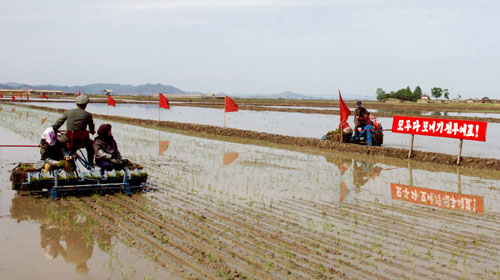Rice & Iron team has been interested in the city of Hyesan for a long time. While rice prices in this border city are often higher than those in Pyongyang and Sinuiju, Hyesan has traditionally enjoyed lower price volatility relative to the capital. This phenomenon can be most likely attributed to the city’s intimate trade relations with China. While this usually meant a more stable supply of food in the city, recent events also show that this relationship alone may not protect the city from wild fluctuations in prices.
The volume of goods entering North Korea through Hyesan is most likely lower than the amount imported via Sinuiju; however, the distance between Yangkang Province (which Hyesan is in) and the capital also provides many opportunities. According to sources inside North Korea, alongside the critical supply of rice imported through Hyesan, the city also acts as an important entrepot for smuggled goods which spur North Korea’s budding consumer economy.
Imported Chinese grain are usually mixed in with domestic rice by vendors in public marketplaces due to consumer preference for more glutinous characteristic of domestic rice. Nonetheless, recent measures granting greater price autonomy to shop owners have boosted sales of Chinese rice at public market places as retailers lowered prices to better compete with rice sold at the jangmadang. The positive effect of this market process was reflected in market data collected by Daily NK which noted a 250 KPW fall in rice prices from June to July (standing at 4800 KPW in Hyesan between July 12 and 18).
The Korean People’s Won (KPW) has also been gaining in strength since May vis-a-vis the US dollar, no doubt improving the import capabilities of the North Korean market.
Despite these positive developments for domestic consumers, insider information gathered by the Daily NK noted that rice prices in Yangkang and North Hamgyeong provinces have been increasing, reaching 6,000 KPW per kilo in some parts. Although price spikes in North Korea are not unprecedented, the Rice & Iron team had not read of reports of a 1000 KPW week-to-week jump since prices stabilized in early 2013.
The Daily NK article that reported the event presented several possible reasons for why the price increases may have occurred.
- Reduced rations have increased demand and affecting prices
- Below-average yield of early new potatoes created domestic scarcity, fueling price increases
- Kwon Tae Jin from the GS&J Institute speculated that the drought in eastern China may have negatively impacted imports
- Kwon also contemplated the negative impact of travel restrictions to prevent the spread disease
The first hypothesis appears to have been largely dismissed by the internal source as prices in cities near mining operations (like Masan) remained high despite the workers there receiving rations.
The remaining hypotheses all carry some weight; however, the reports of the price increases appear (for now) limited to the northeastern parts of the country – the absence of similar stories coming from other peripheral areas like Kangwon Province render us unable to critically analyze this recent development.
Meanwhile consumer attitude in North Korea appears divided on near-future market movements.
Some people in the affected regions are concerned that prices may climb even higher, to 7000 KPW, as they expect the flooding from the monsoons to negatively impact the upcoming harvest of barley, corn, and rice. On the other hand, many also remain optimistic that the bump in domestic food availability at the end of the lean season will bring prices back down.
More to come.

